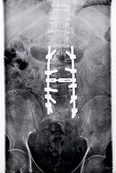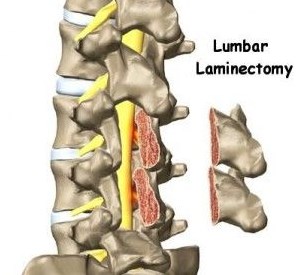A laminanectomía o laminectomídecompressive surgery is a surgical procedureúthat seeks to excise the arch óseo of the vévertebra that covers the nerve, known as heámina. This técnica allows to alleviate the presión the nerves raquígods and the méspinal game. It is frequently used in the treatment of spinal stenosis and the vertebral arthrodesis.
When non-invasive treatments fail, a laminectomy is necessaryíto relieve sísymptoms that interfere with daily life. Candidates for a Laminectomyíto present:
- Constant back pain of severe magnitude.
- Dificulty to walk.
- Weakness or numbness in the legs.
- Incontinence.
These sísymptoms are characteristic of a narrowing of the medullary canal that exerts pressureón on the méspinal game. If this narrowing is located in the upper part of the spine (narrow cervical canal), a laminectomy should be appliedía cervical. If it is located in the lower back (narrow lumbar canal) laminectomy is recommendedía lumbar.
Narrowing of the spinal canal causes disorders including degenerative disc disease, spinal stenosis, herniated disc, osteophytosis or espondylosis. In many cases there may be two or moreás of these conditions together.
Index
Laminectomía Cervical
It's an interventionón wantúrgic that is performed at neck level, on its back. Se realization una eliminationóscheduled number of láspinal canal mines or any other soft tissue that may be causing compressionón on the méspinal game.
Reasons to have a laminectomyíthe cervical are varied, but mainly to treat pressure on spinal nerves in the neck and alsoén like a méall to stabilize the cervical spine.
¿Whaté occurs in the posterior neck?
The spinal canal is a túIn the óbone of the spine, in which are the médula and spinal nerves. when you areúnel is reduced by tamañor the spinal nerves and/or the méspinal cord exerting pressureónot on the same.
At this time the sípain symptoms, numbness, a sensationóno tingles, general stiffness and weakness. When it is at the cervical level, it usually manifests itself in the shoulders, arms and hands.
Laminectomía Lumbar
The laminectomyía lumbar también is known as decompressionón open lumbar and applied for degenerative disorders. Comúcommonly performed to treat lumbar spinal stenosis.
it's a tétechnology is saidñada to remove part of the bone above or below the raíz of the nerve in order to free space. The procedure involves an incisionón of 5 a 12 cm to límidline of the back and when approaching the vertebral column, the laminectomy is appliedíto get to the raínervous stop.
Is he úlast resort used when non-invasive measures have already failed: injections, medicines, physiotherapy, etc.
¿Whaté occurs in the lower back?
Intervertebral discs actúeven as shock absorbers and allow movement of the bones of the spine in the lower back. When those discs shrink, cause pain, numbness and weakness in the legs. This can lead to herniated disc that in the majoría of the cases are treated with a laminectomyía.
Laminectomy preoperativeía
 The méI say recommendá an x-rayía, magn resonanceética or mielografíCT's of the spine, to confirm a spinal stenosis. If the diagnosis is positiveóstico, should be prepared for surgeryía.
The méI say recommendá an x-rayía, magn resonanceética or mielografíCT's of the spine, to confirm a spinal stenosis. If the diagnosis is positiveóstico, should be prepared for surgeryía.
- If you are a smoker, it is a good time to quit.
- Suspend any fádrug that interferes with coagulationóno blood like áacetylsalicylic acidílol, ibuprofen, naproxen, among others. Consult méI indicate which medications can be taken in the period prior to surgeryía.
- Comment on métreating doctor if you suffer from any disease or health problems.
- The díto the surgeryíIt is recommended to go without drinking or eating food, at least 8 hours before the interventionón.
Laminectomy postoperativeía
afterés of the interventionón wantúrgica it is highly probable that the staff méI said I invited him to get up and walk, to check that motor functions did not suffer damageñO. The biggestía of people undergoing laminectomyíto leave the hospital 1 a 3 días, if no complications arise.
Follow the instructions in the mésurgeon to take care of your back at home and in a short time returná to your work routine.
5 Benefits of a laminectomyía
The goal of a laminectomyía is to eliminate the síSymptoms of narrowing of the spinal canal, like pain, numbness, tingling and weakness. In other words restore all functionón nervous.
After a laminectomyíthe following benefits should be achieved:
- Total or partial pain relief.
- decompressionón on the méspinal cord and nerves. Strength does not completely return to normal, but the weakness improves remarkably.
- Preventionón deterioration and abnormal movement of the spine.
- reductionóconsiderable amount of administrationóno of medications.
- stabilizationóGeneral n of the spine and preventionón of new daysños.
Risks of a laminectomyía
 La télaminectom techniqueía is quite safe and there are almost never any problems. Más of the 90% of patients come out of surgeryíto no complications. However, in any interventionón wantúthere will always beá risks, these might be:
La télaminectom techniqueía is quite safe and there are almost never any problems. Más of the 90% of patients come out of surgeryíto no complications. However, in any interventionón wantúthere will always beá risks, these might be:
- infectionón. In the wound and / or the bones of the spine.
- Constant pain that doesn't go away.
- Loss of sensation due to a dayñor in the spinal nerveídeo (with probabilities of occurrence less than 1%).
- Sexual impotence.
- Incontinence.
Aun así, if a laminectomy is not performedíon time, it may make the disease worse and begin to have trouble walking, maintaining balance and a gradual deterioration of motor functions that may end in parálysis.